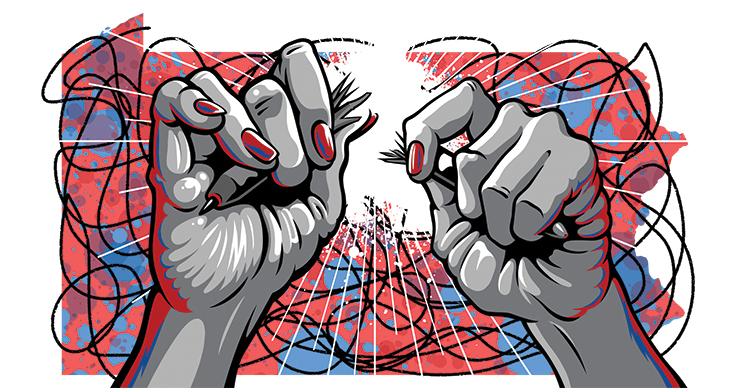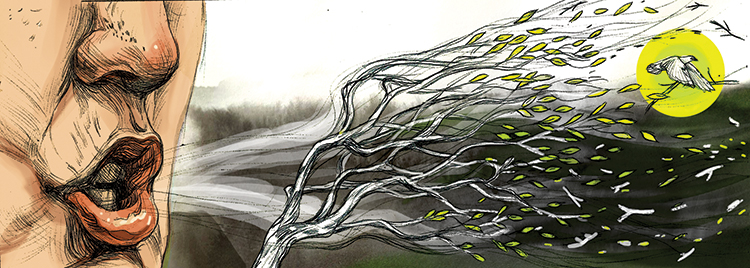Two Pennsylvania court cases could end partisan political districts—possibly even in time for the 2018 elections.
Illustration by Michael Wohlberg
By Kyle Bagenstose
The League of Women Voters of Pennsylvania tackles a long list of pressing issues: drilling in the Marcellus shale, child welfare, collective bargaining and campaign finance among them.
But more than any other, it is gerrymandering—the political process of drawing uneven election maps to heavily favor one party—that sets off alarm bells for league vice president and Chester County native Carol Kuniholm.
“The system is broken, and democracy is dying in Pennsylvania if we don’t fix it,” Kuniholm said.
Gerrymandering is such an important topic for the league that in 2016 members helped launch Fair Districts PA, an organization fighting for competitive elections. Kuniholm serves as chair and says the organization is closely watching two ongoing court cases that, if the pieces fall into place, could require a redraw of Pennsylvania’s 18 congressional districts ahead of next fall’s general elections.
“Normally, the courts don’t involve themselves in a legislative process. It will be interesting to see what happens,” she said.
Also following closely is Michael Li, senior redistrict counsel for the Brennan Center for Justice at New York University.
Li points out that even though Pennsylvania is a closely contested state, usually voting about 50-50 in statewide elections, Republicans hold a 13-to-5 edge in congressional districts. But he’s more troubled by the noncompetitiveness in recent elections.
“The problem is not only the 13-5, but that it’s locked in,” Li said.
Li explains that although gerrymandering has existed for more than 200 years, new technologies now allow politicians to use “surgical” precision in redrawing maps. A redraw by Pennsylvania Republicans in between the 2010 and 2012 elections provides evidence.
In the first election, 51 percent of Pennsylvania voters picked Republicans and 47 percent picked Democrats. Power flipped, with the Republicans gaining five seats for a total of 12.
Two years later Democrats surged back, winning 50 percent of the vote to the Republicans’ 48 percent. But Democrats actually lost a district, and haven’t won one since.
Having seen enough, the League of Women Voters filed suit against the state this year. What happened next was highly unusual: The Pennsylvania Supreme Court ruled 4-3 to fast track the suit and require a lower court judge to render a decision by Dec. 31. Even if the court favors state Republican leaders contesting the suit, the state Supreme Court could overrule it.
“The question becomes, ‘How can you undo [gerrymandering]?’” Li said.
Because primaries would start in the spring, a likely route would be to put in place an independent “special master” to redraw the lines for the 2018 elections, Li said. The court could also favor a request from the league to make new rules for legislators for future redistricting efforts, such as not allowing the use of party registration data in the process.
“The long-term solution is an independent commission,” Kuniholm added.
Should both courts rule in favor of state Republicans, there’s a second, federal gerrymandering case brought by five Pennsylvania voters that began in December. But Li thinks it’s a long shot, as it argues “that you can’t have any partisanship at all” during redrawing, he says.
“This has not been tried before,” Li said. “It potentially opens the door in a way that the U.S. Supreme Court might not be comfortable with… where literally any map is challengeable.”
By June, both suits could be moot, depending on how the Supreme Court rules on a third suit, Gill v. Whitford. The landmark case out of Wisconsin could make highly partisan gerrymandering unconstitutional nationwide. Although the Supreme Court has heard gerrymandering cases in the past and declined to curb it, Li believes new data and mapping technologies allow a higher level of scrutiny that could turn the tide.
Should all fail, Kuniholm says there will be one consolation. Through court documents, she says the public will learn what kinds of conversations went on in 2011 when Pennsylvania Republicans redrew the maps.
“I want people to see these are the names of the people who sat in a room and deliberately denied millions of Pennsylvanians a fair, free vote,” she said. “No matter what the decision in these cases, that information will be made public.”









